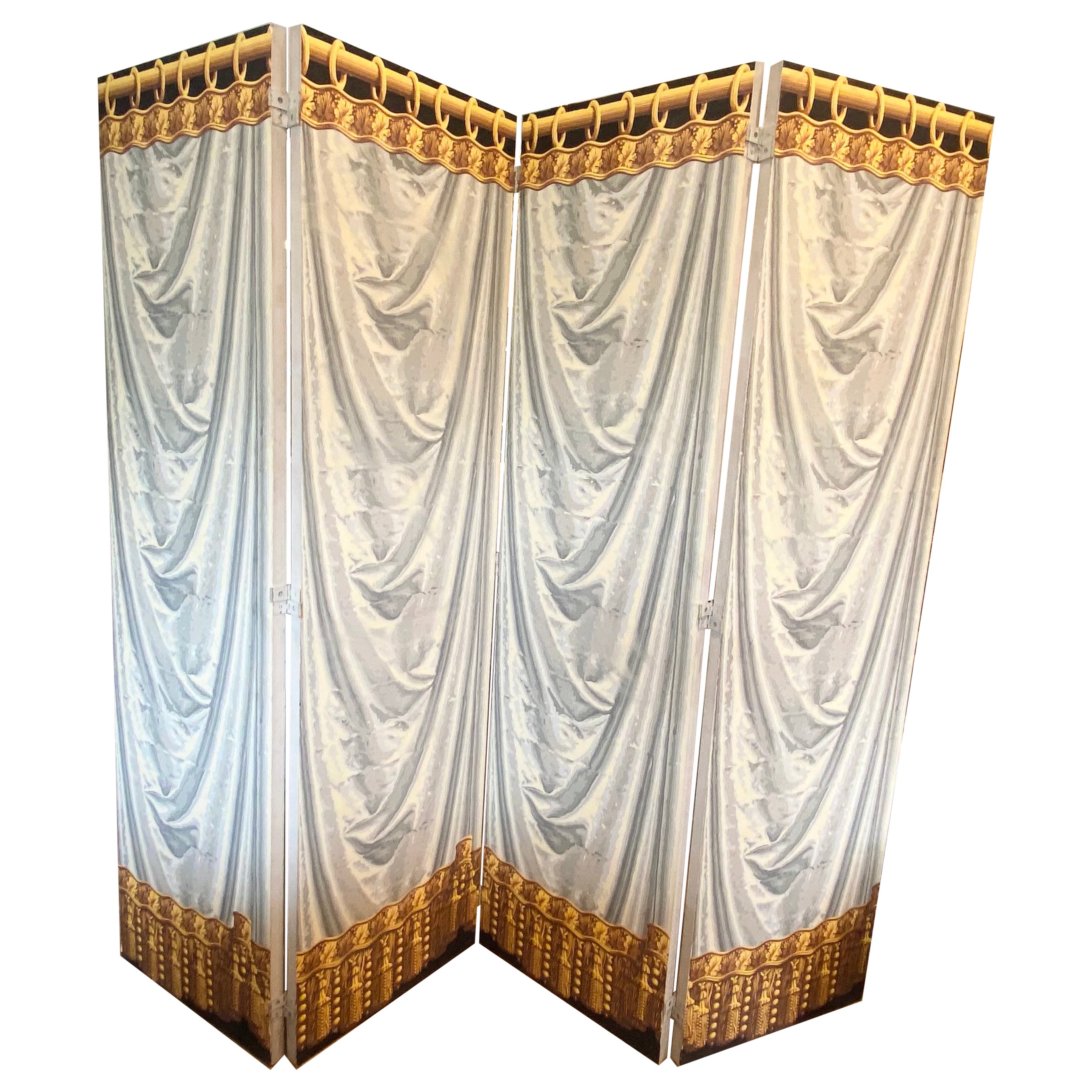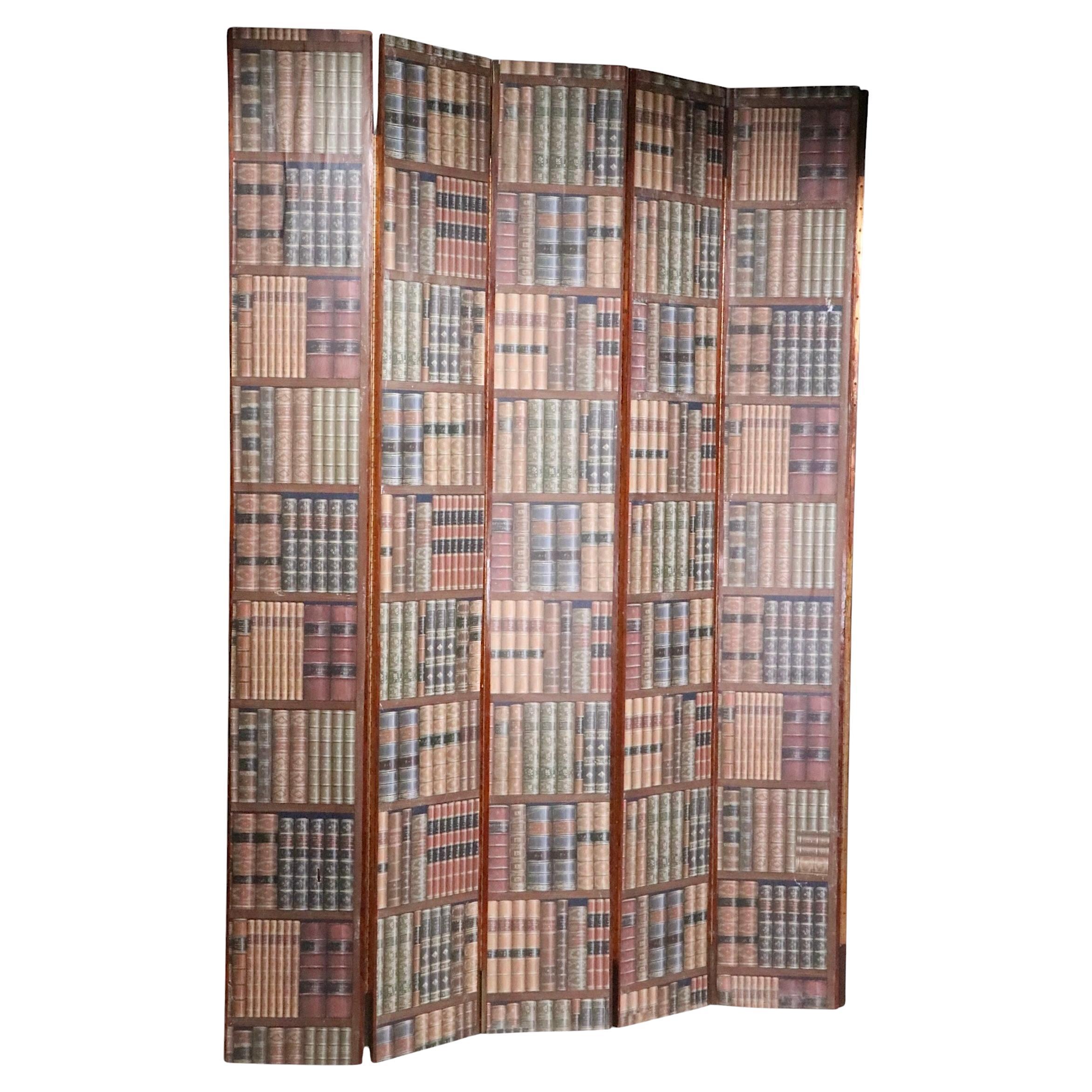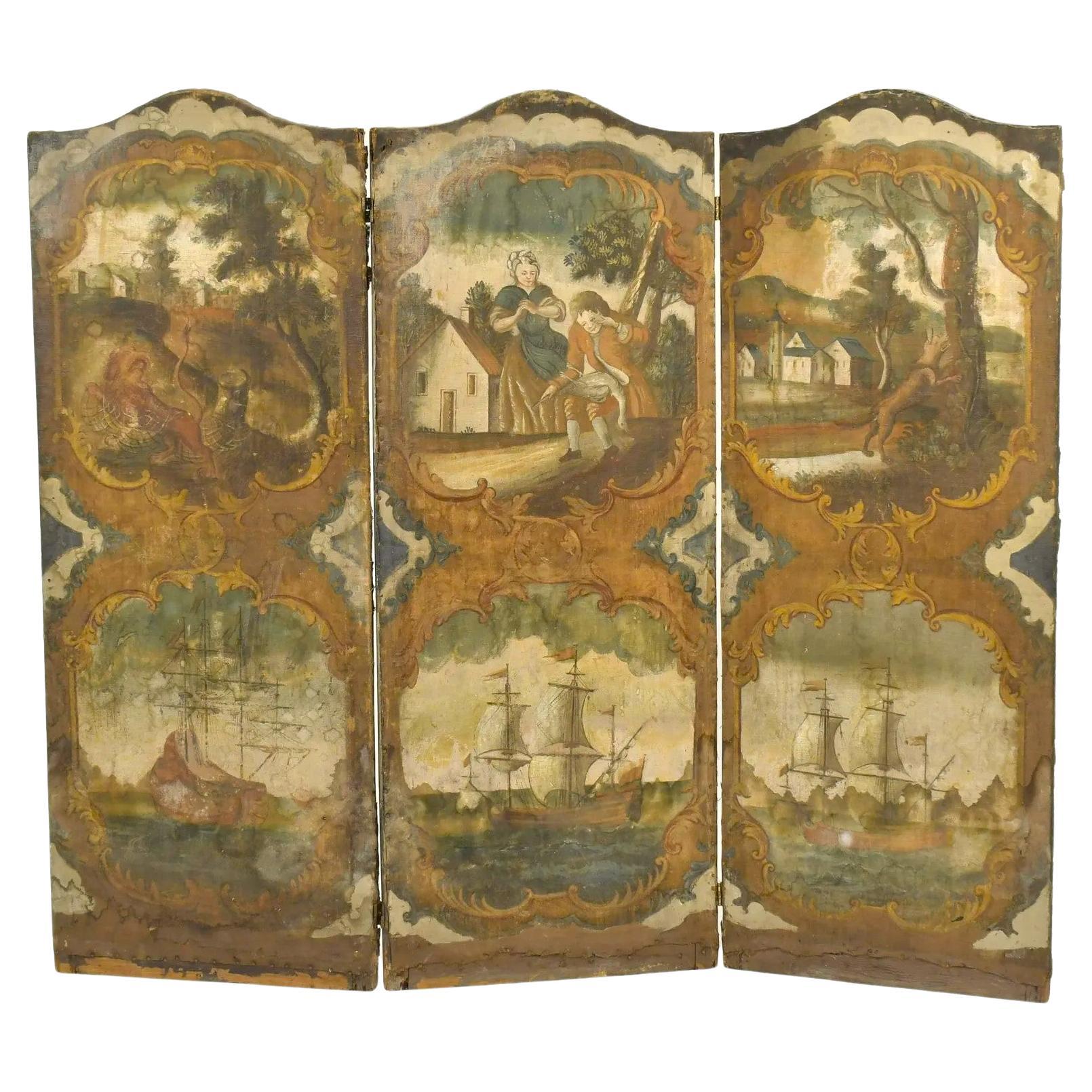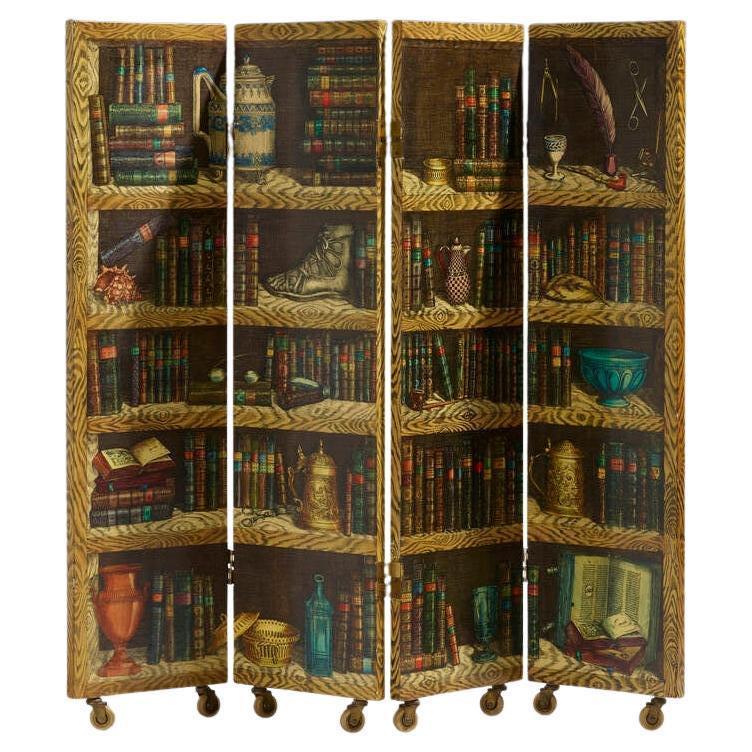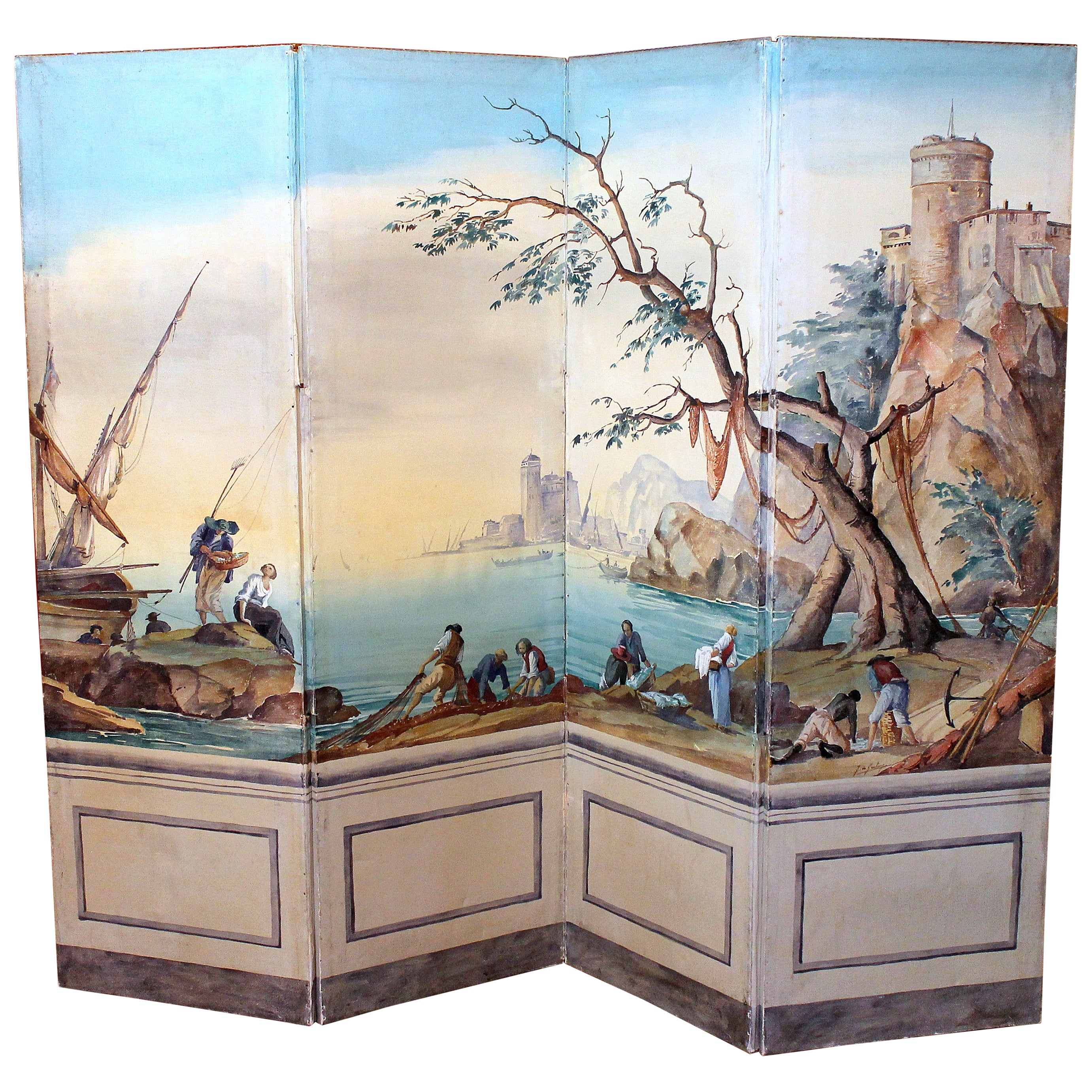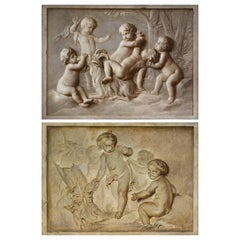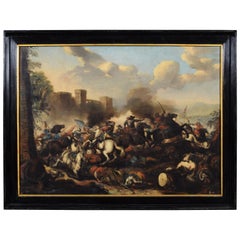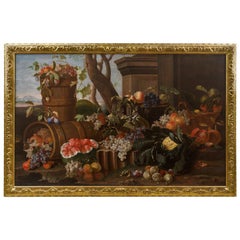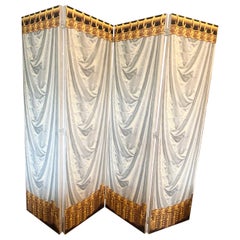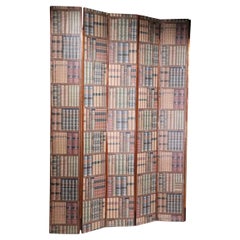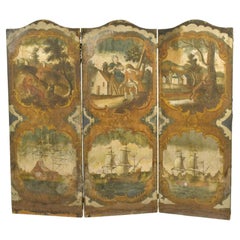Items Similar to 18th Century Italian Neoclassical Oil on Canvas Screen with Trompe L’œil
Want more images or videos?
Request additional images or videos from the seller
1 of 7
18th Century Italian Neoclassical Oil on Canvas Screen with Trompe L’œil
About the Item
18th century, large Italian neoclassical oil on canvas four panels screen with Trompe L’œil
These large screen is composed of four panels in oil on canvas painted. Neoclassical, dating to the second half of the 18th century.
Each panel represents a trompe l'oeil, with a classical architecture with square section marble columns and large clogging. Inside the pink space of the first and third panels are painted, as inserted in a niche with bronze frame, ancient busts in marble: it is, as it reads from the cartouches in faux marble below, of the busts of Emperor Marcus Aurelius and his wife Annia Galeria Faustina. In the lower register, in green space, there are garlands of ribbons, bows and flowers. On the other panels, the painter plays with the illusionist architecture : he have painted two large frames in pink marble, partially covered by two large, soft and voluminous draped curtains, one red and the other in shades of blue. On the thickness of the hoof are represented two putti: the first is intent to move the red curtain, while the other plays with a greyhound who, from the ground, tries to reach him. In the lower part are represented two female heads in grisaille, which simulate marble sculptures. Iconographically must be recognized the goddess Ceres or Demeter, maternal deity of the earth and fertility, the guardian of the harvest and birth.
The frame of the upper frame is moulded with soft and sinuous lines that lighten the architectural structure and increase its decoration.
This screen, of majestic size and of high pictorial quality, lends itself to be inserted, in any room of your house, both alongside antique and modern furnishings. It is also well exposed placed on the wall, as one or four separate paintings. Of great scenic and decorative impact thanks to the trompe l’oeil, it is also extremely pleasant through the dynamism and liveliness of the scene depicted.
Historical and artistic studies are underway in order to better delineate the figure of the painter and the cultural context in which the work was made. New images will be inserted shortly.
Subject with "Certificate of Authenticity".
- Dimensions:Height: 82.29 in (209 cm)Width: 118.12 in (300 cm)Depth: 1.97 in (5 cm)
- Style:Neoclassical (Of the Period)
- Materials and Techniques:
- Place of Origin:
- Period:
- Date of Manufacture:Late 18th Century
- Condition:
- Seller Location:IT
- Reference Number:1stDibs: LU4405218360452
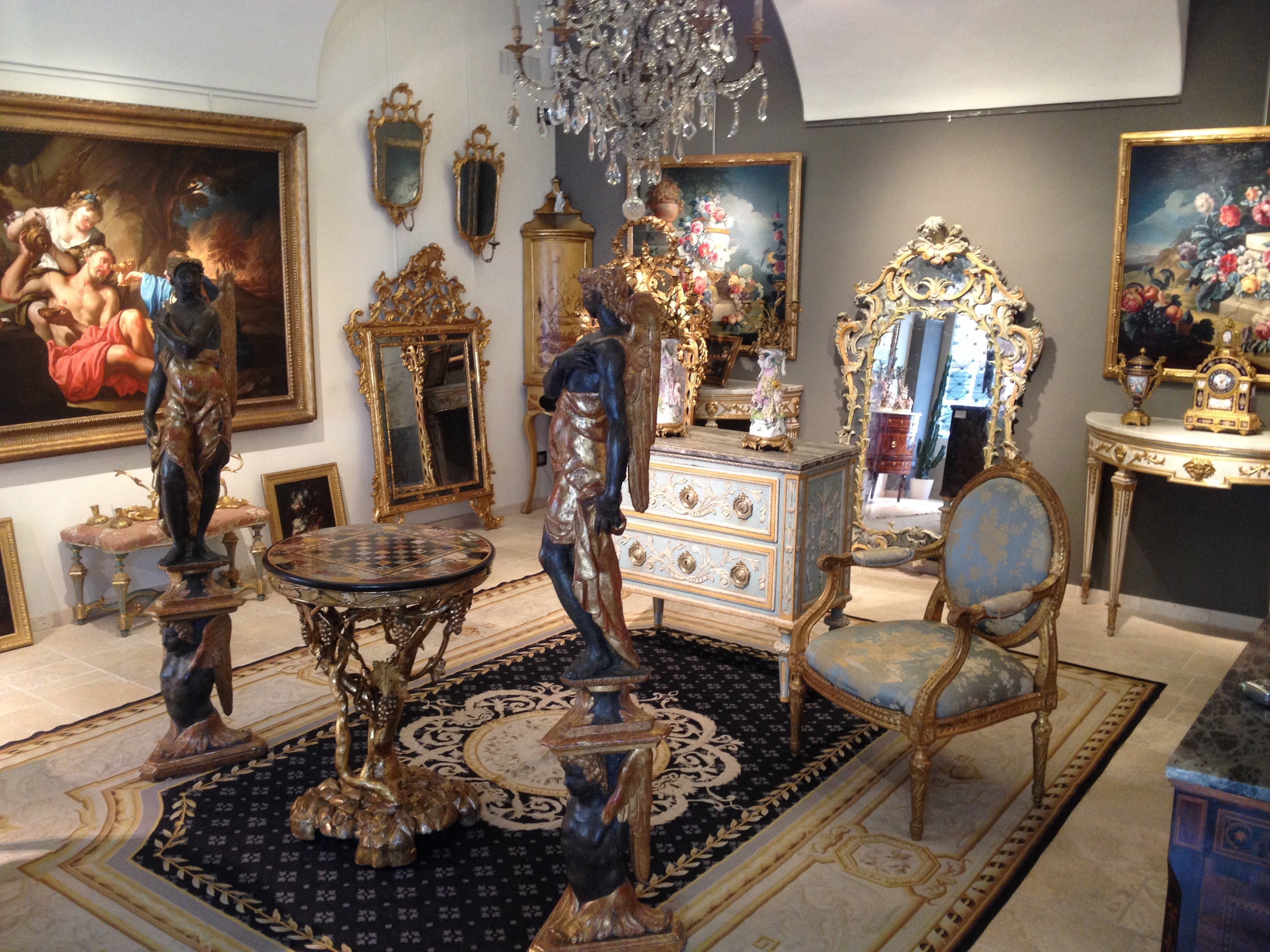
About the Seller
5.0
Platinum Seller
Premium sellers with a 4.7+ rating and 24-hour response times
Established in 1980
1stDibs seller since 2019
53 sales on 1stDibs
Typical response time: <1 hour
- ShippingRetrieving quote...Shipping from: Italy
- Return Policy
Authenticity Guarantee
In the unlikely event there’s an issue with an item’s authenticity, contact us within 1 year for a full refund. DetailsMoney-Back Guarantee
If your item is not as described, is damaged in transit, or does not arrive, contact us within 7 days for a full refund. Details24-Hour Cancellation
You have a 24-hour grace period in which to reconsider your purchase, with no questions asked.Vetted Professional Sellers
Our world-class sellers must adhere to strict standards for service and quality, maintaining the integrity of our listings.Price-Match Guarantee
If you find that a seller listed the same item for a lower price elsewhere, we’ll match it.Trusted Global Delivery
Our best-in-class carrier network provides specialized shipping options worldwide, including custom delivery.More From This Seller
View AllFrench Oil on Canvas Paintings, Trompe l’œil, Attributed P. J. Sauvage
By Piat Joseph Sauvage 1
Located in IT
18th century, pair of French Louis XVI oil on canvas paintings with trompe l’œil, attributable to Piat Joseph Sauvage (Tournai, 1744–1818)
Size: cm H 94 x L 132 each
The pair o...
Category
Antique Late 18th Century French Louis XVI Paintings
Materials
Canvas
$22,751 Sale Price
20% Off
18th Century, Italian Oil on Canvas Painting with Landscape with Ruins
Located in IT
18th century, Italian oil on canvas painting with landscape with ruins
Measures: only the canvas cm W 97.5 x H 108; with the frame cm W 103.5 x H 114 x D 5
The fine oil on canv...
Category
Antique 18th Century Italian Baroque Paintings
Materials
Canvas
18th Century Italian Oil on Canvas Painting with Battle by Antonio Calza
By Antonio Calza
Located in IT
Antonio Calza (Italy, Verona, 1653-18th April 1725)
"Battle between Christian and Turkish cavalry with castle"
The painting depicts a bloody battle between Christian and Turkish cavalry. Characterized by dynamism, intensity of color and light, the main scene occupies the lower horizontal section of the canvas, optically interrupted by the black fumes of the shots from which emerge, on the left, the towers of a fortress. On the right, in the distance you can see the combat in progress in the countryside, beyond which you can see the pale presence of hills that create a fifth, marking the horizon. To frame the scene contributes to the left, against light and in the foreground, a portion of the wall. The painter, however, introduces a horse on the ground, of which we see only the back, a ruse to involve the observer making him become active and participate in the scene. In the foreground, lifeless bodies, wounded horses and, scattered on the ground, weapons and a drum enhance the drama of the clash.
The excitement and expressive force, the intense chromatic range attentive to the conditions of light and the fine brushstrokes, decisive and dramatic, suggests the attribution to Antonio Calza, one of the most important painters of battles of the seventeenth century, excellent student and continuator of the greatest interpreter of the genre, Jacques Courtois called il Borgognone (Saint-Hyppolite 1621 - Rome 1676). Il Borgognone, although not having had a real school or direct students, places itself as a primary reference point by the Italian and foreign "battaglisti".
The genre of battle painting found great success in the collections of the Italian and European nobility of the seventeenth and eighteenth centuries. The battles of the Italian Renaissance, in which the scene converged towards a precise protagonist, evolve towards a type of combat "without hero". The bloody realism of the details and the dynamic development of the narrative confuse the figure of the protagonist, when present, to give importance to the swirl of horses and armed fighters, among which, moreover, does not emerge a winner.
The certain documents relating to the life and movements of Antonio Calza are scarce; it was equally difficult to reconstruct, from the critics, a catalogue of autograph works. Through paintings in private collections, in museums and paintings passed on the antiques market it has been possible to identify a copious corpus of works that can be traced back to his hand. The work of art historians, together with that of antique dealers, in conferring proper attributions in order to best outline the figure of Calza, continues but studies are still in progress. In this sense, the work of Giancarlo Sestieri should certainly be noted, who investigated the artistic production of the battaglisti and Calza, thus allowing the comparison of the numerous photographic works reported, to identify and recognize the stylistic qualities that distinguish the corpus of paintings assigned to him today.
Antonio Calza was born in 1653 in Italy, in Verona and in 1664 he entered the school of Carlo Cignani in Bologna, dedicating himself to painting battles and landscapes. He then perfected in Rome, where he knew the works of the then undisputed head of the sector, Jacques Courtois called the Burgundian. In 1675 he returned to Verona and married an 88-year-old widow who, dying, left him a rich inheritance. Much appreciated by the nobility and the bourgeoisie, he received numerous commissions. Bartolomeo Dal Pozzo (Le Vite de' pittori, de gli scultori et architetti veronesi, 1718) praises "three great paintings of battles...
Category
Antique Late 17th Century Italian Baroque Paintings
Materials
Canvas
$31,573 Sale Price
20% Off
18th Century, Italian Oil on Canvas Still Life by Pietro Navarra
Located in IT
18th century, Italian oil on canvas still life by Pietro Navarra
Oil on canvas, canvas measures: cm H 103 x W 164, framed measures...
Category
Antique 18th Century Italian Baroque Paintings
Materials
Canvas
$44,691 Sale Price
30% Off
18th Century, Italian Pair of Oil on Canvas Paintings by Francesco Simonini
By SIMONINI
Located in IT
Francesco Simonini (Parma, 16 June 1686 - Parma, 1766)
“The rest of the soldiers” and “The march of soldiers”
oil on canvas
cm 40 x 58 and 40 x 60 ; frame: h 52,5 x W 70,5 x D 6 an...
Category
Antique Early 18th Century Italian Baroque Paintings
Materials
Canvas
$27,162 Sale Price
35% Off
19th Century, Italian Neoclassical Walnut Library Staircase
Located in IT
19th Century, Italian Neoclassical Walnut Library Staircase
The particular library staircase was built in the neoclassical era, around the beginning of the 19th century, in Piedmont...
Category
Antique Early 19th Century Italian Neoclassical Ladders
Materials
Walnut
You May Also Like
Trompe L'Oeil Wallpaper Four Panel Screen
Located in East Hampton, NY
Wonderful 4 panel wallpaper screen made of hollow core wood and papered on both sides similarly with draped fabric. elegant trompe l'oeil paper ...
Category
Late 20th Century Screens and Room Dividers
Materials
Paper
6 Panel Faux Library Trompe L'oeil Folding Screen
Located in New York, NY
Impressive six fold room divider, screen featuring a faux library with antique leather bound books. The screen is constructed of six plywood panels, each 12 inch W, each having appli...
Category
Mid-20th Century American Bohemian Screens and Room Dividers
Materials
Plywood, Paper
Early 18th Century 3-Panel Folding Screen, French
Located in Doylestown, PA
An early 18th century French 3-panel folding screen, oil-on-canvas, depicting village and maritime scenes in cartouches with other decoration.
Category
Antique Early 18th Century Screens and Room Dividers
Materials
Canvas
Trompe L’oeil “Libri” Four-Panel Folding Screen By Piero Fornasetti.
By Piero Fornasetti
Located in Montreal, QC
lithographic transfer-printed and lacquered wood trompe L"oeil “Libri” four-panel folding screen by Piero Fornasetti the reverse with musical instruments Fornasetti Milano Italy, 195...
Category
Vintage 1950s Italian Screens and Room Dividers
Materials
Wood
1950s Chinese Coromandel Four-Panel Screen with Trompe-l'œil Bookshelves and Gil
Located in London, GB
The front of the screen features a trompe-l'œil depiction of bookshelves filled with meticulously painted books, scrolls, and manuscripts adorned with Chinese calligraphy in vibrant ...
Category
Vintage 1950s Chinese Chinese Export Screens and Room Dividers
Materials
Wood
French Early 20th Century Tempera on Canvas Folding Screen with Seascape View
Located in Firenze, IT
This French early 20th Century folding screen is made up of four canvases entirely painted with textured tempera featuring a marine l...
Category
Early 20th Century French Screens and Room Dividers
Materials
Metal
